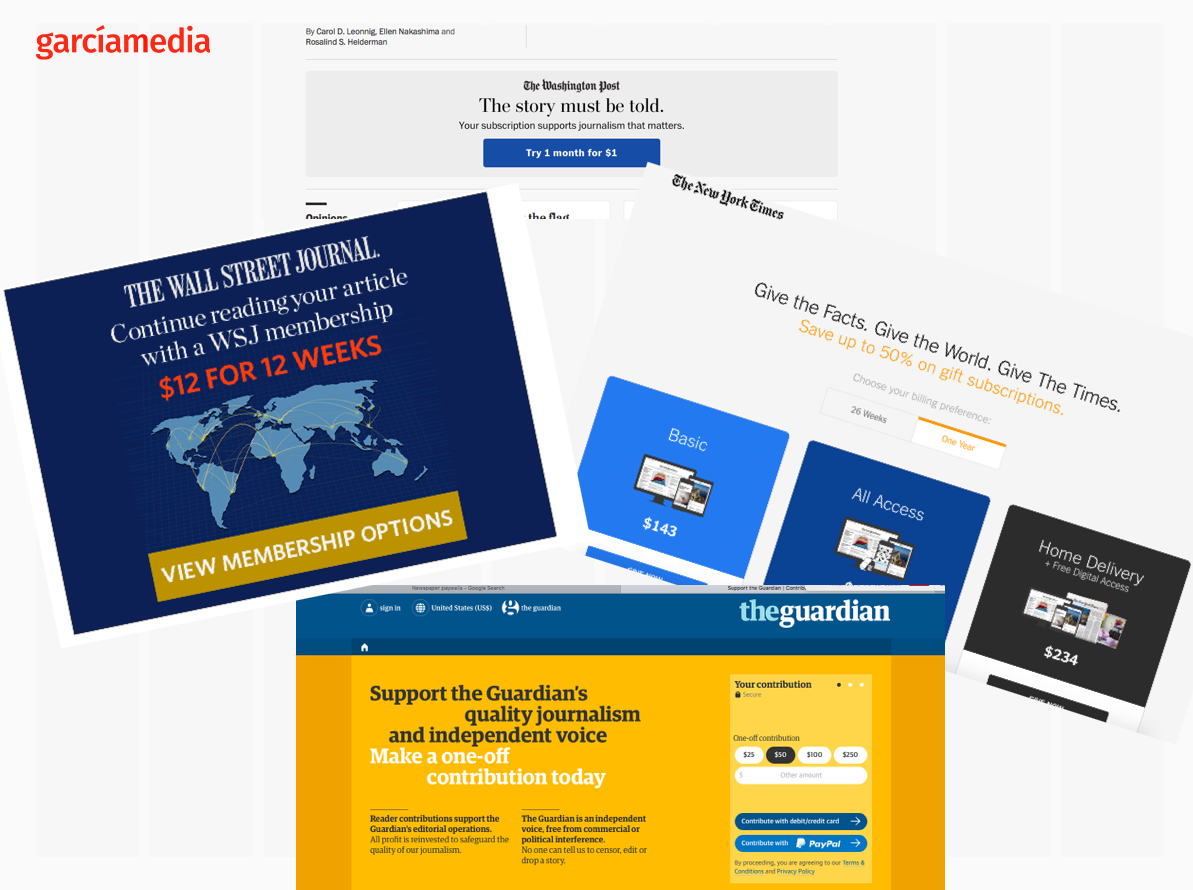My workshop may be devoted to visual storytelling, but, regardless of topic, the first or second question following my presentation is always about paywalls. Three such questions:
Which newspaper that you know of have the best strategy for monetizing its operation via a paywall?
Can you cite a few strategies to monetize the operation via pay-as-you-read?
How many articles should a newspaper provide for free, before putting a wall and asking readers for their credit card information?
While paywalls for newspapers are not my area of expertise, I now found useful information in this new Columbia Journalism Review (CJR) research.
The CJR folks concluded that the majority of the US’s largest newspapers continue to employ digital subscription strategies that prioritize traffic, ad revenues, and promotion—despite the ongoing collapse of display ad rates.
Because the notion of paywalls doing the job seems to be different at various newspapers, the CJR study found that a full 10 sites, 40 percent of the outlets studied looked at, focused on ad revenue exclusively, eschewing paywalls.
Two interesting highlights of the CJR study:
The paywalled news sites, 15 in total, diverged widely in the cost of their subscriptions, the number of free articles dispensed, the specific combination of “side door” exceptions employed, and whether they operated via one flagship website or two—one free and one for subscribers.
Even as they’ve added paying Web subscribers by the hundreds of thousands, daily newspapers have decisively rejected an all-in approach featuring “hard” website paywalls that mimic their print business models. Instead, most are employing either “leaky” paywalls with unlimited “side doors” for non-subscribers or no paywalls at all, according to a CJR analysis of the nation’s 25 most-visited daily newspaper sites.
Paywalls come in categories

And because we are in hurricane season and are quite familiarized with the various categories of hurricanes that describe their intensity and possible threat, I think it is safe to say, after reading the CJR conclusions, that “paywalls”, like hurricanes, also come in categories. Some barely make landfall.
-Hard Paywalls
There are the hard paywalls, such as the one The Wall Street Journal employed until last year, with no metered articles or “side doors.” Exception: the Boston Globe comes closest. The paywall at BostonGlobe.com was the only one in the CJR study that had no unlimited exceptions . Non-subscribers get ONLY two metered articles per month.
-Leaky Paywalls
There are the most abundantly found so called leaky paywalls: with unlimited “side doors”: data gathering, promotion, and a continued central role in the public conversation. For more about “side doors” go here.
–The “very leaky” paywall
A handful of other publishers, including McClatchy and Gannett , are employing a paywall strategy at the opposite extreme to the Globe’s, leaving all three “side doors” open.
–The two-website, “metered freemium” model
Also another category of paywalls is the “freemium” structure, which works in some ways like the “leaky” paywall, allowing the company to pursue both subscriptions and high traffic and ad revenue at the same time. This approach creates two different experiences that target two distinct audiences, each with its own monetization model.
The no-paywall approach
A total of 10 of the 25 newspapers employed no paywall whatsoever, making all their content freely available online.
Optimism abounds
The CJR study concludes with rather optimistic statements, including this one from Mark Aldam, president Hearst Newspapers whose outlets employ “leaky” paywalls.
“The menu of paid experiences [online] will continue to expand. The possibility for success in the paid digital economy is on the rise.”
I say amen to that. I now have a better framework to answer those questions I face following my presentations. This CJR is must read for everyone in our business.
Digital Media North America
http://events.wan-ifra.org/events/digital-media-north-america-2017

This two-day event, organized jointly by WAN-IFRA and the News Media Alliance (NMA), will provide a unique opportunity for North American news media executives to hear and discuss digital revenue strategyfrom the world’s most advanced media companies.
I will be one of the speakers for this conference in New York City.
Finalists in the Digital Media contest 2017
https://mailing.wan-ifra.org/vm.php?m=4769&u=ed7c3017381fb21f96ef5cf355e244e7
Mario’s Speaking Engagements
Oct. 19, WAN IFRA Digital Media North America, New York City
Nov. 16-19, WAN IFRA Latin America, Buenos Aires, Argentina
TheMarioBlog post #2705